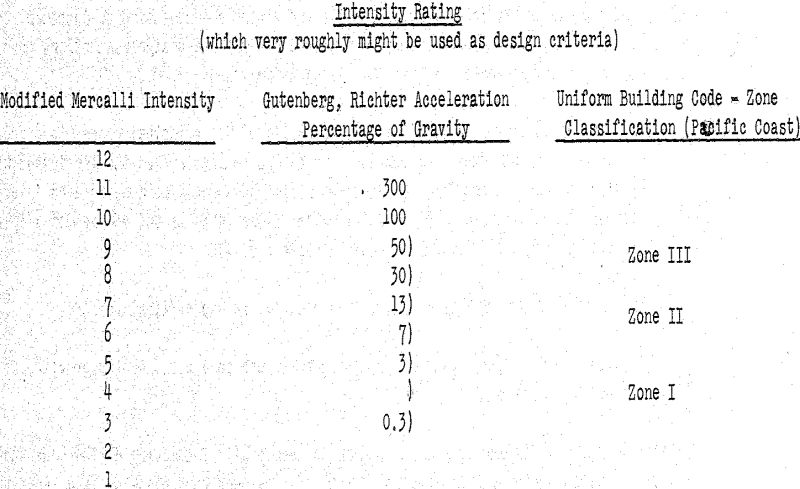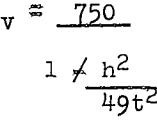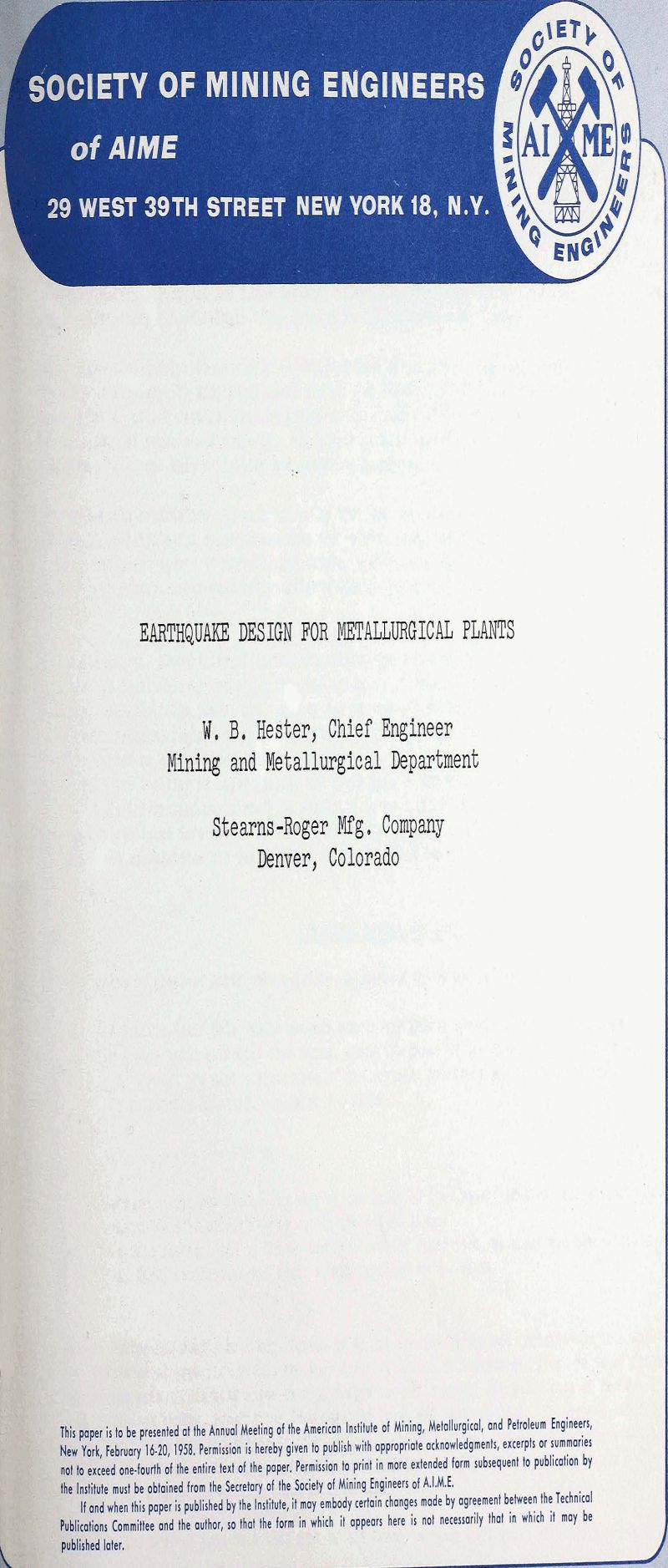Table of Contents
All persons and communities that have experienced strong-motion earthquakes are convinced of the importance and complexity of earthquake problems that must be solved in order to reduce the personal hazards and property losses to a reasonable minimum. It is also clear that absolute elimination of all risks is impossible. Reduction of existing hazards and precautionary measures which will minimize chances for disaster can be accomplished by realistic appraisal of the effects of recent earthquakes on modern structures and installations. Localities that have reason to expect so-called strong- motion earthquakes can anticipate these effects by taking appropriate steps.
Principal Earthquake Areas
The areas of greatest earthquake activity, as defined, by Gutenberg & Richter, are:
A. The Pacific Basin belt, which extends completely around, the rim of the Pacific Ocean.
B. The Alpide belt, extending from Burma, along the front of the Himalayas, across Asia, and on through the Alpine structures of the northern Mediterranean Basin in Europe, thence out into the Atlantic, ending at the Azores,
C. There are minor but frequently very active areas in the Indian, Arctic, and Atlantic Oceans, which consist of rift zones within the mature masses,
D. In stable masses, even in the Continental core of older rock, we sometimes have small shocks; in fact, earthquakes can occur almost anywhere on the earth.
The United States has really been very fortunate as far as earthquakes are concerned as only about two percent of the total area lies within the very definite limits of the world is great belts of frequent violent earthquakes.
Magnitude Acceleration Strong Motion
For many years seismologists have measured the violence of earthquake motion by means of an earthquake intensity scale such as the Modified Mercalli Scale of 1931 now used, in this country. The scale is divided into 12 grades and is based on the effects of earthquake vibrations on animate and inanimate objects.
Grade Intensity
I. Not felt except by a very few under especially favorable circumstances (I Rossi-Forel Scale)
II. Felt only by a few persons at rest, especially on upper floors of buildings. Delicately-suspended objects may swing. (I to II Rossi-Forel Scale)
III. Felt quite noticeably indoors especially on upper floors of buildings, but many people do not recognize it as an earthquake. Standing motor cars may rock slightly. Vibration like passing truck. Duration estimated. (III Rossi-Forel Scale)
IV. During the day felt indoors by many, outdoors by few. At night some awakened, Dishes windows, doors disturbed walls make creaking sound. Sensation like heavy truck striking building. Standing motor cars rocked noticeably (IV to V Rossi-Forel Scale)
V. Felt by nearly everyone many awakened. Some dishes, windows, etc broken a few instances of cracked plasters unstable objects overturned. Disturbances of trees, pole and other tall objects sometimes noticed. Pendulum clocks may stop. (V to VI Rossi-Forel Scale)
VI. Felt by all many frightened and run outdoors. Some heavy furniture moved a few instance of fallen plaster or damaged chimneys. Damage slight. (VI to VII Rossi-Forel Scale).
VII. Everybody runs outdoors. Damage negligible in buildings of good, design and construction; slight to moderate in well-built ordinary structures; considerable in poorly-built or badly-designed structures; some chimneys broken. Noticed by persons driving motor cars.
VIII. Damage slight in specially-designed structures considerable in ordinary substantial buildings with partial collapse; great in poorly-built structures. Panel walls thrown out of frame structures. Pall of chimneys, factory stacks, columns, monuments, walls. Heavy furniture overturned. Sand and mud ejected in small amounts. Changes in well water. Disturbs persons driving motor cars. (VIII/ to IX Rossi-Forel Scale)
IX. Damage considerable in specially-designed, structures; well-designed frame structures thrown out of plumb; great in substantial buildings, with partial collapse. Buildings shifted, off foundations. Ground cracked conspicuously. Underground pipes broken. (IX Rossi-Forel Scale)
X. Some well-built wooden structures destroyed most masonry and frame structures destroyed with foundations; ground, badly cracked. Rails bent. Landslides considerable from river banks and. steep slopes. Shifted sand and mud. Water splashed, (slopped.) over banks. (X Rossi-Forel Scale),
XI. Few, if any, (masonry) structures, remain standing. Bridges destroyed. Broad fissures in ground. Underground pipelines completely out of service. Earth.slumps and land slips in soft ground. Rails bent greats.
XII. Damage total. Waves seen on ground surfaces. Lines of sight and level distorted. Objects thrown upward into the air.

For engineering purposes it is not the magnitude of an earthquake which is significant but, rather, the intensity of the surface ground motion. The surface intensity is greatest near the center of the shock and diminishes with increasing distance from the center. The intensity of ground motion at any particular point will depend, upon the magnitude of the shock (energy released), the distance from the center of the shock the depth of focus of shock, the type of faulting, and the geological conditions in the vicinity.
Minimum Design Considerations and Cost
Taking all of this into consideration, we must maintain a minimum design with lateral force coefficients equal to the California Zone III Uniform Building Code requirements, which will provide reasonable protection with limited-shutdown time for all but the heaviest earthquakes. It will be obvious to the reader that it is economically impractical to design structures which will experience only minor damage during major earthquakes with an intensity of Modified Mercalli 10.
Earthquake experience demonstrates that the direct damage caused by strong-motion is relatively minor in comparison with the consequences of fires, broken waterlines causing flooding, high voltage electrical surges, release of poisonous gases and a multitude of other secondary effects.
General Design Considerations
The three principal criteria for a seismic design of structures are:
- Choose a reasonable lateral force coefficient giving due attention to Customer, Code, and/or Underwriter’s requirements as applicable.
- Pay careful attention to developing good details of all principal, connections and show sufficient typical details on the design drawings to insure that the fabricator will provide the desired details.
- Either tie everything together, separate clearly, or expect local failure.
- Furnish competent and thorough inspection to insure good construction practice in accord with the design.
Structures designed for seismic forces should be as nearly self-inspecting during construction as possible. Structural steel is obviously better in this respect than cast in-place concrete, particularly for foreign construction.
Site
The general seismicity of a region is important because, according to the elastic rebound theory, massive movements in the earth that have caused earthquakes in the past will persist and cause earthquakes in the future. It is generally agreed that the actual kinetic energy sent out by an earthquake is the suddenly-released, potential strain-energy that accumulates across a major fault as strain accumulates from slow opposing land movements on each side of the fault.
The response of a building and the response of a site to earthquake impulses are mutually interrelated and combined in a complex manner. It is evident that foundation motion is a function of both the properties of the building and the properties of the local geology.
Violent effects and severe damage occur at irregularities in the surface geology, particularly in zones of transition from very fragile to less fragile or solid formations. In this respect, water front installations and structures are the outstanding example.
Local geology responds to earthquake shock in a manner determined by its physical properties, including the position of ground water. In general, the more deformable formations move with greater-accelerations, velocities and displacements than do the less deformable ones.
We cannot hope for protection from large earthquakes by a thick soil cover — such greatly adds to the hazard. We should build when we can on a good transmitter — firm rock. Get the energy past as quickly as possible and with the smallest displacements possible.
Foundations
The effect of the ground, motion is to feed energy into this structure. Some of the energy is dissipated through damping and the remainder is stored in the structure in the form of kinetic energy of motion of the mass and in the form of strain energy of deformation of the structural members. If the energy input is sufficiently large, the structure cannot absorb it in elastic strain energy, for the stresses will exceed the elastic limit with consequent permanent deformations, or some part of the structure will fail. In either event, the deformations, can occur without failure of a member, then at any instant the sum of the kinetic energy plus strain 5 energy plus energy dissipated through normal damping plus energy dissipated through permanent deformation will be equal to the total energy input. It thus follows that if a structure can absorb a large amount of energy through so-called plastic deformation, it will be able to withstand very intense ground motion without failing.
The foundations are the structural link between the earth and the supported structure. Ideally, they might be separated from the structure by low-friction bearings such that during seismic activity the ground and foundations would move together and the structure could remain stationary in space. Practically, such a scheme is not very feasible. Therefore, although the foundations should be designed to transmit a minimum horizontal acceleration of 0.2g to the structure, the acceleration applied to the superstructure is generally used.
The allowable soil bearing pressure may be increased, one-third, when lateral seismic forces are combined with gravity loads except no increase is justified under conditions of poor consolidation (such as loose sand, or sand of nearly equal grain size).
Concrete
The design of structural concrete conforms to the standards of the American Concrete Institute. In general, however, the shear cannot be assumed to be transmitted between contact faces of precast concrete units as indicated in the supplement to their regulations.
Additional requirements include a minimum thickness of 2½ inches for self-supporting concrete slabs but not less than 1/48 of span plus 2 inches. Slabs used as diaphragms cannot be less in thickness than 1/36 the distance between supports or stiffener beams (h) and the allowable shear for slabs used, as diaphragms cannot exceed that given by the formula.

The minimum area of positive or negative reinforcement in beams and girders must be at least 0.6 sq. inches at any point where it is required. In calculating the minimum reinforcement in each direction in slabs the full, thickness of the slab must be used. In concrete joist construction the slab thickness shall be as shown above.
Structural Steel
Steel has a good record. Exceptions to industry standards for the design of structural steel are as follows, l/r ratio of tension bracing members is not limited, provided they are so supported as to reduce sag to an economic minimum. All compression members carrying calculated load must conform to requirements formain compression members. Pipe columns may be designed, at the same stresses as structural steel if the material conforms to ASTM A53 Grade B, or API 5L quality; otherwise structural steel stresses must be reduced by 25%. Where joint rotation is relatively important, bolt holes must be not more than 1/50 inch larger than the bolt diameter and the unthreaded portion of the bolt shall be such that all connected members have full bearing thereon. Welded connections are permitted for all types of loads when details are adequate and the weldments are properly inspected.
Process Equipment
Materials which are released from their containers by earthquake action are special hazards related to a great variety of Installations. Failure of bins, silos, tanks and pipelines permitting the release of masses of solid material, poisonous and combustible liquids and gases, and damaging amounts of water presents innumerable problems. In the design, construction and maintenance of such installations, the potential hazards in addition to the loss of the container and its contents should be fully considered.
Damaged sprinkler systems of buildings causes very considerable loss. Breakage of heads and fittings due to improperly supported lines causes water damage to many buildings and their contents. Water tanks in or supported by buildings are responsible for a disproportionate amount of damage to both the installation and the building. The evidence clearly shows that a full tank acts less violently than when partly full.




